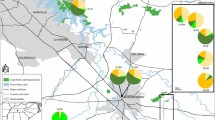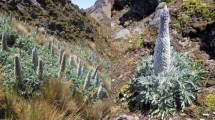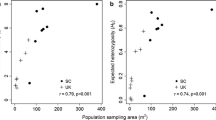Abstract
Galium catalinense (Rubiaceae) is a perennial shrub consisting of two subspecies endemic to California’s Channel Islands: Galium catalinense subsp. catalinense on Santa Catalina Island, and G. catalinense subsp. acrispum, a state-endangered taxon on San Clemente Island. A long history of overgrazing by introduced herbivores has contributed to population declines in G. catalinense subsp. acrispum. We surveyed 12 populations throughout the taxon’s range for genetic variation using eight polymorphic microsatellite loci to determine the genetic impact of this demographic bottleneck. At the taxon level, 65 alleles were identified with an average of 8.1 alleles per locus, although many alleles were rare; the effective number of alleles per locus averaged 2.6. Expected heterozygosity was 0.550. Individual populations had between six and eight polymorphic loci, with expected heterozygosities ranging from 0.36 to 0.60, and effective numbers of alleles ranging from 1.8 to 3.5 per locus. Populations fell into three or four genetic clusters, depending on type of analysis, which may represent refugia where the populations persisted during intense herbivory. There is little evidence of genetic bottlenecks or substantial inbreeding within populations. These findings, coupled with indications of recent migration between populations, suggest that G. catalinense subsp. acrispum is currently unlikely to be endangered by genetic factors, but small population sizes make the taxon vulnerable to future loss of genetic diversity. Management strategies based on these genetic data, population sizes, and the spatial distribution of populations are discussed.





Similar content being viewed by others
References
Armbruster G, Pfenninger M (2003) Simulated bottlenecks and loss of rare alleles: implications on the conservation genetics of two gastropod species. J Nat Conserv 11(2):77–81
Beauchamp RM (1987) Endangered and candidate plant status inventory, San Clemente Island, Los Angeles County, California. Pacific Southwest Biological Services, National City
Chung JM, Lee BC, Kim JS, Park CW, Chung M, Chung MG (2006) Fine-scale genetic structure among genetic individuals of the clone-forming monotypic genus Echinosophora koreensis (Fabaceae). Ann Bot 98:165–173
Cornuet JM, Luikart G (1997) Description and power analysis of two tests for detecting recent population bottlenecks from allele frequency data. Genetics 144:2001–2014
Corry P (2006) Vegetation dynamics following grazing cessation on the Channel Islands, California. Dissertation, University of North Carolina at Chapel Hill
David P, Pujol B, Viard F, Castella V, Goudet V (2007) Reliable selfing rate estimates from imperfect population genetic data. Mol Ecol 16:2474–2487
Di Rienzo A, Peterson AC, Garza JC, Valdes AM, Slatkin M, Freimer NB (1994) Mutational processes of simple sequence repeat loci in human populations. Proc Natl Acad Sci USA 91:3166–3170
Dieringer D, Schlotterer C (2003) Microsatellite Analyser: a platform independent analysis tool for large microsatellite datasets. Mol Ecol Notes 3:167–169
Dodd SC, Helenurm K (2002) Genetic diversity in Delphinium variegatum (Ranunculaceae): a comparison of two insular endemic subspecies and their widespread mainland relative. Am J Bot 89:613–622
Donlan C, Tershy B, Croll D (2002) Islands and introduced herbivores: conservation action as ecosystem experimentation. J Appl Ecol 39:235–246
Donlan C, Croll D, Tershy B (2003) Islands, exotic herbivores, and invasive plants: their roles in coastal California restoration. Restor Ecol 11(4):1–7
Doyle JJ, Doyle JL (1987) A rapid DNA isolation procedure for small quantities of fresh leaf tissue. Phytochem Bull 19:11–15
Ellstrand NC, Elam D (1993) Population genetic consequences of small population size: implications for plant conservation. Annu Rev Ecol Syst 24:217–242
Endels P, Jaquemyn H, Brys R, Hermy M (2007) Genetic erosion explains deviation from demographic response to disturbance and year variation in relic populations of the perennial Primula vulgaris. J Ecol 95:960–972
Erskine-Ogden J, Rejmánek M (2005) Recovery of native plant communities after the control of a dominant invasive plant species Foeniculum vulgare: implications for management. Biol Conserv 125:427–439
Evanno G, Regnaut S, Goudet J (2005) Detecting the number of clusters of individuals using the software STRUCTURE: a simulation study. Mol Ecol 14:2611–2620
Excoffier LGL, Schneider S (2005) ARLEQUIN ver 3.0: an integrated software package for population genetics data analysis. Evol Bioinform Online 1:47–50
Falk DA, Holsinger KE (1991) Genetics and conservation of rare plants. Oxford University Press, New York
Falush D, Stephens M, Pritchard J (2003) Inference of population structure using multilocus genotype data: linked loci and correlated allele frequencies. Genetics 164:1567–1587
Falush D, Stephens M, Pritchard J (2007) Inference of population structure using multilocus genotype data: dominant markers and null alleles. Mol Ecol Notes 7(4):574–578
Frankham R (1997) Do island populations have less genetic variation than mainland populations? Heredity 78:311–327
Friar E, Prince L, Roalson EH, McGlaughlin ME (2006) Ecological speciation in the East Maui-endemic Dubautia (Asteraceae) species. Evolution 60:1777–1792
Furches M, Wallace L, Helenurm K (2009) High genetic divergence characterizes populations of the endemic plant Lithophragma maximum (Saxifragaceae) on San Clemente Island. Conserv Genet 10(1):115–126
Garcillán P, Ezcurra E, Vega E (2008) Guadalupe Island: lost paradise recovered? Overgrazing impact on extinction in a remote oceanic island as estimated through accumulation functions. Biodivers Conserv 17(7):1613–1625
Guillot G, Mortier F, Estoup A (2005) Geneland: a program for landscape genetics. Mol Ecol Notes 5:712–715
Hairston N Jr, Ellner S, Kearns C (1996) Overlapping generations: the storage effect and the maintenance of biotic diversity. In: Rhodes OE, Chesser RK, Smith MH (eds) Population dynamics in ecological space and time. University of Chicago Press, Chicago, pp 109–143
Halvorson WL (1992) Alien plants at Channel Islands National Park. In: Stone CP, Smith CW, Tunison JT (eds) Alien plant invasions in native ecosystems of Hawai’i: management and research. Cooperative National Park Resources Unit, University of Hawaii, Honolulu, pp 64–96
Halvorson WL (1994) Ecosystem restoration on the California Channel Islands. In: Halvorson WL, Maender GL (eds) Fourth California Islands symposium: update on the status of resources. Santa Barbara Museum of Natural History, Santa Barbara, pp 485–490
Hartl DL, Clark AG (1989) Principles of population genetics, 2nd edn. Sinauer and Associates Inc., Sunderland
Helenurm K (2001) High levels of genetic polymorphism in the insular endemic herb Jepsonia malvifolia. J Hered 92(5):427–432
Helenurm K (2003) Genetic diversity in the rare, insular endemic Sibara filifolia (Brassicaceae). Madrono 50:181–186
Helenurm K, Hall S (2005) Dissimilar patterns of genetic variation in two insular endemic plants sharing species characteristics, distribution, habitat, and ecological history. Conserv Genet 6(3):341–353
Helenurm K, West R, Burckhalter S (2005) Allozyme variation in the endangered insular endemic Castilleja grisea. Ann Bot 95(7):1221–1227
Hubisz M, Falush D, Stephens M, Pritchard J (2009) Inferring weak population structure with the assistance of sample group information. Mol Ecol Resour 9(5):1322–1332
Jump AS, Marchant R, Peñuelas J (2008) Environmental change and the option value of genetic diversity. Trends Plant Sci 14(1):1360–1385
Junak SA, Wilken DH (1998) Sensitive plant status survey, NALF San Clemente Island, California. Technical Report No 1. Santa Barbara Botanic Garden, Santa Barbara
Junak S, Ayers T, Scott R, Wilken D, Young D (1995) A flora of Santa Cruz Island. Santa Barbara Botanic Garden, Santa Barbara
Keegan D, Coblentz B, Winchell C (1994) Feral goat eradication on San Clemente Island, California. Wildl Soc Bull 22(1):56–61
Klinger R, Schuyler P, Sterner J (2002) The response of herbaceous vegetation and endemic plant species to the removal of feral sheep from Santa Cruz Island, California. In: Veitch C, Clout M (eds) Turning the tide: the eradication of invasive species: proceedings of the international conference on eradication of island invasives. Occasional paper of the IUCN Species Survival Commission No. 27, pp 141–154
Knowlton J, Donlan CJ, Roemer G (2007) Eradication of non-native mammals and the status of insular mammals on the California Islands, USA and the Pacific Baja California Peninsula Islands, Mexico. Southwest Nat 52(4):528–540
Kramer AT, Havens K (2009) Plant conservation genetics in a changing world. Trends Plant Sci 18(3):147–155
Lauretto M, Nakano F, Faria S Jr (2009) A straightforward multiallelic significance test for the Hardy–Weinberg equilibrium law. Genet Mol Biol 32(3):619–625
Leinonen T, O’Hara RB, Cano JM, Merila J (2007) Comparative studies of quantitative trait and neutral marker divergence: a meta-analysis. J Evol Biol 21:1–17
Luikart G, Cornuet JM (1998) Empirical evaluation of a test for identifying recently bottlenecked populations from allele frequency data. Conserv Biol 12(1):228–237
McEachern A, Thomson D, Chess K (2009) Climate alters response of an endemic island plant to removal of invasive herbivores. Ecol Appl 19(6):1574–1584
McGlaughlin ME, Friar E (2007) Clonality in the endangered Ambrosia pumila (Asteraceae) inferred from RAPD markers; implications for conservation and management. Conserv Genet 8:319–330
McGlaughlin ME, Wallace L, Helenurm K (2008) Isolation of microsatellite loci from the endangered plant Sibara filifolia (Brassicaceae). Mol Ecol Resour 8(2):367–369
McGlaughlin ME, Riley L, Helenurm K (2009) Isolation of microsatellite loci from the endangered plant Galium catalinense subspecies acrispum (Rubiaceae). Mol Ecol Resour 9(3):984–986
Mitsui Y, Isagi Y, Setoguchi H (2009) Isolation and characterization of microsatellite loci in Ainsliaea faurieana (Asteraceae), an endemic plant species on Yakushima Island, Japan, and cross-species amplification in closely related taxa. Mol Ecol Resour 9(3):877–879
Moore RJ (1975) The Galium aparine complex in Canada. Can J Bot 53(9):877–893
Nei M (1977) F-statistics and analysis of gene diversity in subdivided populations. Ann Hum Genet 41:225–233
Petit R, Hampe A (2006) Some evolutionary consequences of being a tree. Annu Rev Ecol Evol Syst 37:187–214
Philbrick R (1980) Distribution and evolution of endemic plants of the California Islands. In: Power DM (ed) The California Islands: proceedings of an interdisciplinary symposium. Santa Barbara Museum of Natural History, Santa Barbara, pp 173–187
Pimm SL, Jones HL, Diamond J (1988) On the risk of extinction. Am Nat 132(6):757–785
Piry S, Luikart G, Cournet JM (1999) BOTTLENECK: a computer program for detecting recent reductions in the effective population size using allele frequency data. J Hered 90:502–503
Pritchard J, Stephens M, Donnelly P (2000) Inference of population structure using multilocus genotype data. Genetics 155:945–959
Proctor MP, Yeo P, Lack A (1996) The natural history of pollination. Timber Press, Portland
Randall K (2008) Southern California Range Complex environmental impact statement/overseas environmental impact statement. Department of the Navy, United States Navy Pacific Fleet, San Diego
Raven PH (1963) A flora of San Clemente Island, California. Aliso 5:289–347
Raymond M, Rousset F (1995) GENEPOP (version 1.2): population genetics software for exact tests and ecumenicism. J Hered 86:248–249
Reusch TBH, Ehlers A, Hämmerli A, Worm B (2005) Ecosystem recovery after climatic extremes enhanced by genotypic diversity. Proc Natl Acad Sci USA 102(8):2826–2831
Siol M, Bonnin I, Olivieri I, Prosperi JM, Ronfort J (2007) Effective population size associated with self-fertilization: lessons from temporal changes in allele frequencies in the selfing annual Medicago truncatula. J Evol Biol 20(6):2349–2360
Slatkin M (1985) Rare alleles as indicators of gene flow. Evolution 39:53–65
Theodorou K, Couvet D (2006) Genetic load in subdivided populations: interactions between the migration rate, the size and the number of subpopulations. Heredity 96:69–78
Tsuda Y, Ide Y (2005) Wide-range analysis of genetic structure of Betula maximowicziana, a long-lived pioneer tree species and noble hardwood in the cool temperate zone of Japan. Mol Ecol 14(13):3929–3941
Van Oosterhout C, Hutchinson WF, Wills DPM, Shipley P (2004) MICRO-CHECKER: software for identifying and correcting genotyping errors in microsatellite data. Mol Ecol Notes 4:535–538
Wallace GD (1985) Vascular plants of the Channel Islands of southern California and Guadalupe Island, Baja California, Mexico. Contributions in Science No. 365 Natural History Museum of Los Angeles County, Los Angeles, CA
Wallace L, Helenurm K (2006) Characterization of microsatellite loci in polyploid Lavatera assurgentiflora ssp assurgentiflora and ssp glabra (Malvaceae). Mol Ecol Notes 6(2):331–333
Wallace L, Helenurm K (2009) Has herbivory negatively impacted genetic variability in the flora of the California Channel Islands? Insights from Crossosoma californicum (Crossosomataceae). Int J Plant Sci 170(3):311–322
Wallace L, Furches M, Helenurm K (2006) Polymorphic microsatellite loci in Lithophragma maximum (Saxifragaceae), an endemic plant of San Clemente Island. Mol Ecol Notes 6(2):459–461
Wilson GA, Rannala B (2003) Bayesian inference of recent migration rates using multilocus genotypes. Genetics 163:1177–1191
Wright S (1951) The genetic structure of populations. Ann Eugen 15:323–354
Zavaleta E, Hobbs R, Mooney H (2001) Viewing invasive species removal in a whole-ecosystem context. Trends Ecol Evol 15(8):454–459
Acknowledgements
This research was funded by the Natural Resource Office, Staff Civil Engineer, Naval Air Station, North Island, San Diego, CA. Thanks to Jonathan Dunn and Julie Lambert for tissue collection.
Author information
Authors and Affiliations
Corresponding author
Rights and permissions
About this article
Cite this article
Riley, L., McGlaughlin, M.E. & Helenurm, K. Genetic diversity following demographic recovery in the insular endemic plant Galium catalinense subspecies acrispum . Conserv Genet 11, 2015–2025 (2010). https://doi.org/10.1007/s10592-010-0094-8
Received:
Accepted:
Published:
Issue Date:
DOI: https://doi.org/10.1007/s10592-010-0094-8




